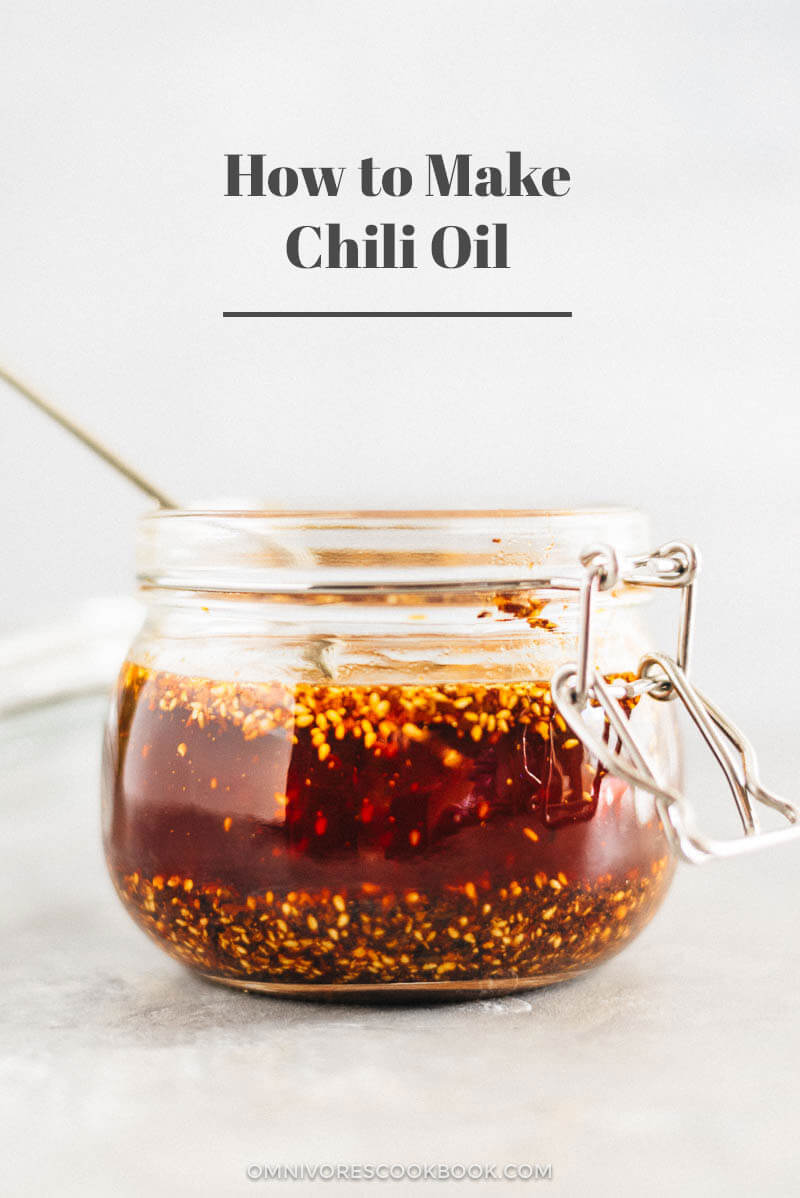
Chili oil is such an important staple for Chinese families, equal to soy sauce and vinegar. For many Chinese people chili oil is as important as ketchup is to American people. It always shows up on tables of small diners, no matter whether it’s a dumplings or noodle place. Once you’re hooked, you’ll want to pour it on everything.
Whenever I’m talking about chili oil, I always refer to homemade chili oil. It tastes ten times better than the store bought product, lasts just as long if you store it in the fridge, and does not contain additives or MSG. There is this fresh aromatic nuttiness that bottled chili oil never delivers.
Plus, when you use chili oil like a Chinese person, you gotta mix in the chili flakes as well. The chili flakes are well toasted when you cook the chili oil, so they taste less spicy but quite smoky with a crispy texture. When mixing with noodles, these tiny umami bits coat the ingredients evenly and each bite releases waves of piquant zing to your taste buds. It’s as exciting as throwing a handful of Pop Rocks in your mouth!
When I cook Vegetable Chow Mein, Lanzhou Beef Noodle soup, and hearty Sesame Noodle Salad, I’ll always spoon a few dollops of chili oil mixed with thick chili flakes onto my finished dish. This one small action will elevate your cooking from mundane to heavenly.
Cooking process
The process might look intimidating at first, but you won’t believe how easy it is once you try it. There are three steps involved.
(1) Combine chili flakes with aromatics of your choice in a heatproof bowl.
A ceramic bowl is my go-to choice. If you plan to use a glass jar, make sure it is heatproof. We will be dealing with hot oil in the next step. Using glassware might cause the glass to shatter and can be very dangerous.
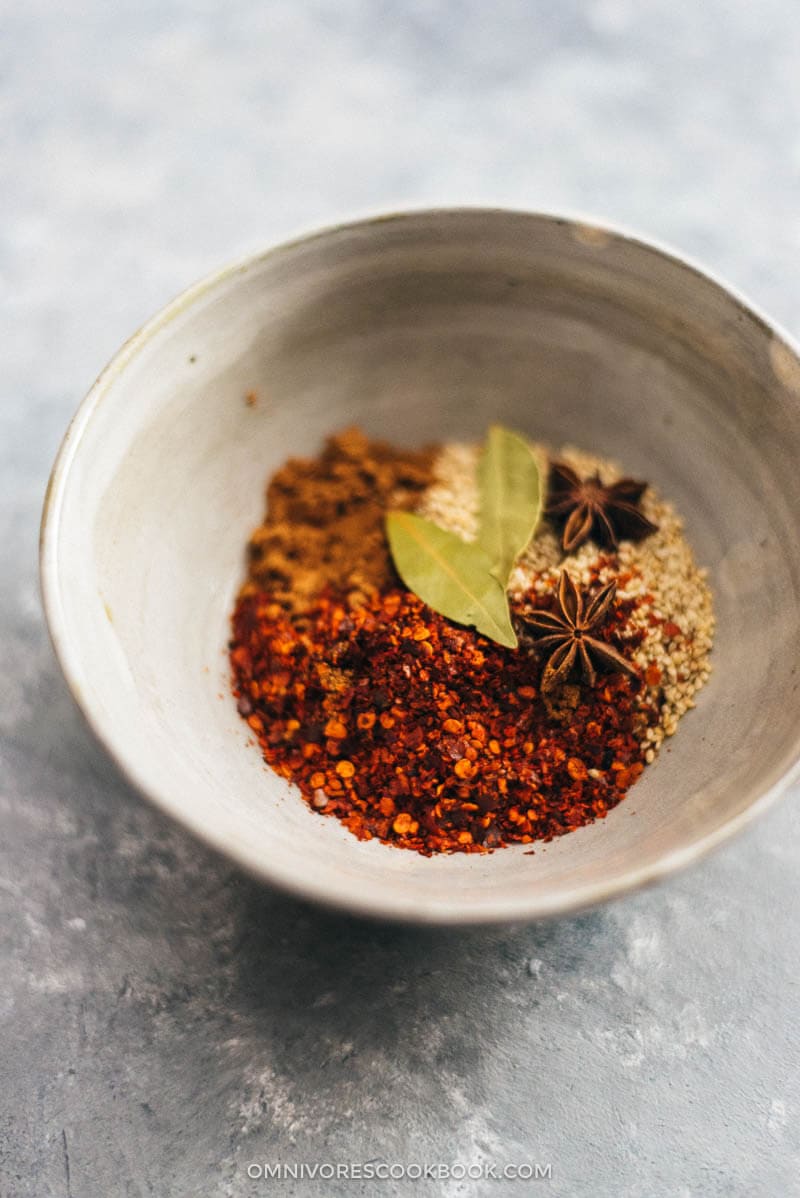
(2) Heat the oil until it reaches 370 degrees F (190 C).
The key to making delicious chili oil is to heat the oil hot enough without overheating it. The hot oil will cook the spices thoroughly and be infused with various flavors. However, if the oil is too hot, it will burn the pepper flakes and sesame seeds, and the resulting chili oil will be bitter in taste.
The best way is to use an instant thermometer to monitor the oil. If you do not have a thermometer, I also introduce a “ginger method” in the recipe below, which is a good indicator of the oil temperature.
Select a small saucepan that has long handle and is good for pouring. Alternatively, you can also use a ladle to transfer the oil.
(3) Pour oil into the bowl with chili flakes.
The oil will bubble fiercely at first and quickly cook the chili flakes. Simply mix everything together with a spoon and let the oil sit until cooled down.
That’s it! Now you have a jar of delicious chili oil to use to create an authentic Chinese flavor.
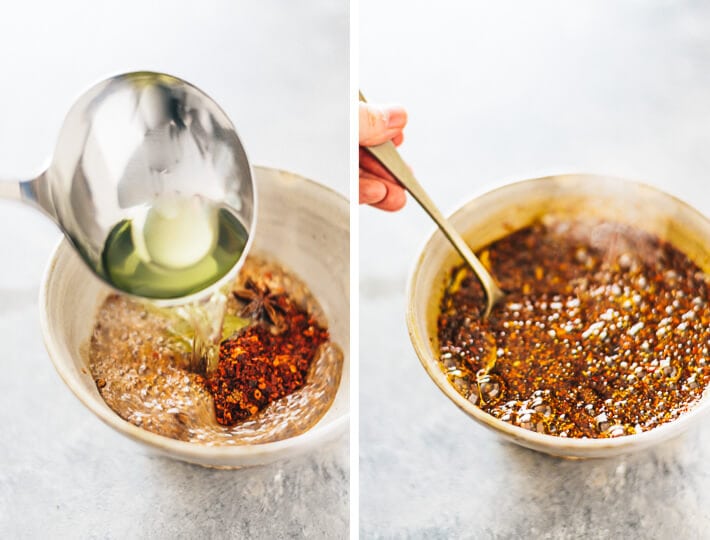
More cooking notes
(1) What types of chili flakes should you use?
The best option is to use fresh chili flakes imported from Sichuan. This type of chili flake is made with premium chili peppers of a vibrant red color. The blend also contains fewer seeds, so your chili oil won’t end up overly spicy.
The next best option is using Korean chili flakes. With these, I found my chili oil doesn’t have the brightest red color, but it doesn’t affect the taste.
(2) How do you make chili flakes?
You can use whole dried chili peppers to make chili flakes too. Lightly toast the peppers in a pan until the pepper turns a bit darker, and grind the peppers into chili flakes. To make sure the oil won’t turn out too spicy, cut open half of the hot peppers with kitchen shears and discard the seeds.
(3) What types of aromatics should you use in the chili oil?
The answer is, you can use many types of aromatics or none at all. The flavor is totally up to personal preference. In China, each region down to each family has their own formula to make their favorite chili oil.
To make the most basic chili oil, you can simply use chili flakes. Some versions use ginger, cinnamon bark, bay leaves, star anise etc.
The recipe below is our family’s formula. We always enjoy adding a few Sichuan peppercorns to add a hint of numbing nuttiness. We also use a pinch of five spice powder to add umami.
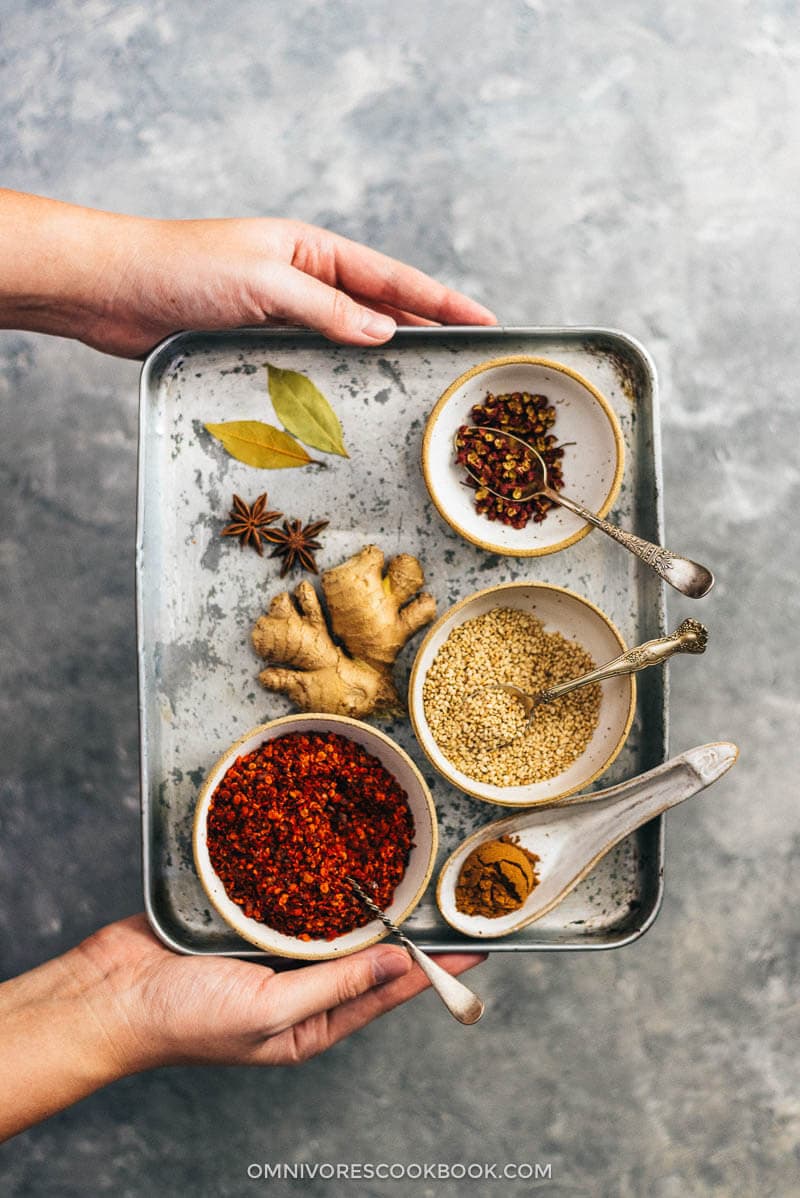
(4) To filter or not to filter the chili flakes?
Once you’ve made the chili oil, you can either filter the oil and discard the chili flakes, or you can leave them in. This habit varies a lot in China depending on the region, so I’d say both methods are authentic and correct.
As a northerner, I grew up having chili oil with tons of chili flakes sitting at the bottom. In fact, in many restaurants you will find the chili oil jar is filled mostly chili flakes and very little oil.
Again, if you choose proper chili flakes (see point #1 above), your chili oil will not be very spicy and it should taste nutty with a balanced umami flavor. The chili flakes should add texture and smokiness to your dish, not spiciness.
How to use chili oil
- Make authentic Sichuan food: Mapo Tofu, Sichuan Spicy Wonton in Red Oil, Sichuan Sliced Beef in Chili Sauce (Fu Qi Fei Pian), Bang Bang Chicken
- Drizzle on soup to make them taste better immediately: Wonton Soup, Instant Pot Chicken Noodle Soup, 15-Minute Curry Ramen with Leftover Ham
- Make a simple cold dish taste irresistible: Real Deal Sesame Noodles, Cucumber Salad
- Use it on congee and oatmeal: 5-Ingredient Savory Oatmeal (Chinese-Style)
- Use it on your roast veggies to add tons of flavor (extremely helpful if you follow a vegetarian or vegan diet)
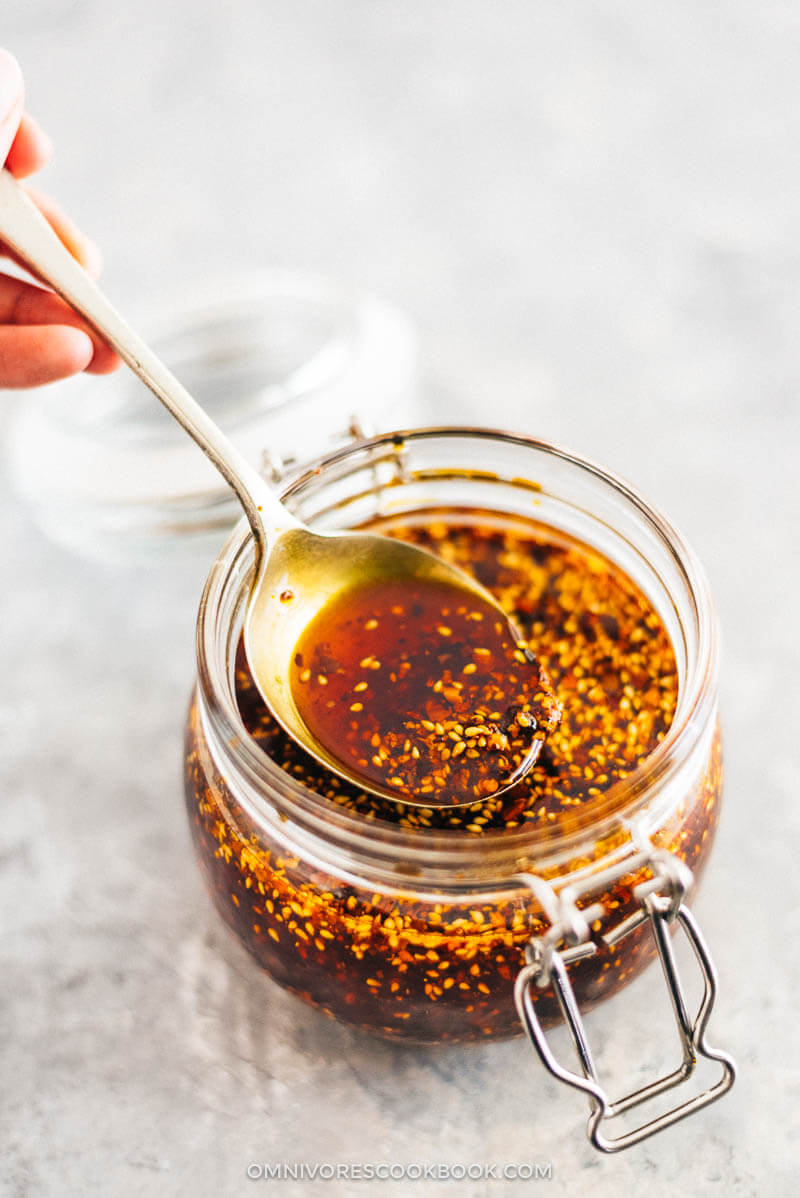
Other homemade Chinese sauces & condiment
- Chinese BBQ Sauce
- Chinese Flavored Sweet Soy Sauce
- Vegetarian Oyster Sauce
- Homemade Black Bean Sauce
If you give this recipe a try, let us know! Leave a comment, rate it (once you’ve tried it), take a picture and tag it @omnivorescookbook on Instagram! I’d love to see what you come up with.
Chinese Cooking Made Easy
Are you new to this website? This free email series is a great place to start. I’ll walk you through a few of my most popular recipes and show you how and why they work. You’ll quickly start to cook better Chinese food in your own kitchen.
Watch video
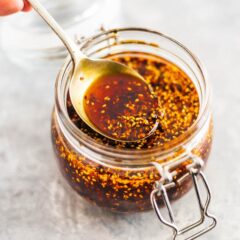
How to Make Chili Oil (辣椒油)
Ingredients
- 4 tablespoons Chinese chili flakes (*footnote 1)
- 2 teaspoons five spice powder
- 3 tablespoons toasted sesame seeds
- 1 teaspoon ground Sichuan peppercorn
- 1 whole star anise (Optional)
- 2 bay leaves
- 1 cup vegetable oil (or grapeseed oil)
- 1 piece thinly sliced ginger (Optional)
Instructions
- Combine chili flakes, five spice powder, sesame seeds, star anise, Sichuan peppercorns, and bay leaves in a heatproof ceramic bowl that can hold at least 2 cups liquid. Place the bowl on a heat resistant coaster.
- Heat oil in a wok (or a skillet) over medium-high heat. Add ginger. When the ginger starts to wither and turns golden brown, immediately turn off the heat. The oil should reach 370 degrees F (190 C) and no higher than 400 F (200 C) if read with an instant thermometer.
- Carefully pour oil or use a ladle to transfer oil into the bowl of mixed spices. The oil will bubble for a few seconds and cook the spices. While the the oil is bubbling, use a metal spoon to stir gently to mix the spices, so they’ll cook thoroughly.
- When the oil cools down a bit, scoop out and discard the star anise and bay leaf.
- The oil is now ready to use! Its flavor will mature if you let it rest for a day, allowing the spices to infuse into the oil.
- The oil can be stored covered at room temperature for two weeks, or up to six months in the fridge in an airtight container.
Notes
Nutrition

Did you make this recipe?
I’d love to hear how it turned out for you! Please take a moment to leave a 5-star rating ⭐️ and share your thoughts in the comments further down the page. It really helps others discover the recipe too.
The recipe was originally published on August 7, 2014, and updated on April 23, 2017.

Beryl
This recipe turned out great – simple, and really elevates chinese food made at home (or takeout eaten at home:) ) I hope to find some good chinese peanut oil, and make my next batch with that!
AMbk
Thank you Maggie! I had tried to make chili oil following a different recipe elsewhere, and it ended up being a disaster. Following your steps, I was successful this time around. So excited to use this in my cooking! Delicious, fragrant and wonderful!
Tim
Hi – I’ve made once with canola. But would you use caiziyou since I have it? Thanks!
Maggie
Yes, Caiziyou will totally work!
A-Rho
Revolutionary. Will be making this for years to come.
Maureen
Thank you I love this
Anton
Thank you for sharing this recipe Maggie. I made it for Dan Dan noodles and it was delicious! I used Korean pepper flakes which is just the right amount of heat for me. I would say the star anise is necessary – it’s what makes this chili oil the best I’ve ever had!! And so easy, there’s no reason to buy store bought anymore.
Maggie
So happy to hear you like the recipe 🙂 I always have a jar in my fridge and I put it on many dishes to boost flavor.
Lawri Smith
Tried it and loved it. Thank you.
Terri Caldwell
I have several different chili oils but when I made this I was ready to throw the rest out! This is so amazingly good that I use it every day on everything. Make it!
Amber
Hello Maggie,
Have not tried this yet but am excited to get it going. One question before I begin… The peppercorns are purchased whole but the recipe calls for ground peppercorns. Could you explain this a bit more for me please? I’ve experienced these babies before and I really don’t want to add more than required ’cause I feel like that’d be a chili oil disaster for me. I’m eventually using the oil to make your Mapo Tofu.
Thanks!!
Amber
Maggie
Hi Amber, I usually use my coffee grinder to ground the Sichuan peppercorns. You can use a mortar and pestle as well. If you do not wish to have a strong peppercorn taste in the chili oil, you can simply use the whole peppercorns when pouring the hot oil, then you can fish them out afterwards. j
Amber
Cheers! Thank you.
Barbara
Hi! I made it and will remake it again 🙂 I used the same ingredients as your recipe and the sauce is really easy to make, full of flavours, and goes with so many dishes, thanks a lot !
Barbara
Sabena
The phrase “you can use korean chili flakes” is goodsend to me and I’m sure many others. Thank you!!! My chili oil looks and smells incredible. You are right, no more buying chili oil. Is it alright to add salt and sugar
Zoe
My FAVORITE chili oil recipe. I can’t go back to store bought. The anise seed pod really kicks the flavor up a notch and adds to the complexity.
Eric Nelson
Very easy to make. Not as hot as one would expect given the amount of chili’s. It is however extremely fragrant.
Instead of using a ceramic bowl, I used a 2 cup pyrex measuring cup which worked just fine since the borosilicate glass can easily take the heat. Doesn’t hurt to preheat the glass with not water to lessen the temperature drop.
Jacqueline
This is a wonderful chili oil recipe. This is my first attempt at making this and it came out great. Second attempt I left out one bay leave, and the star anise. Third attempt I left out half the toasted sesame. My forth attempt today I added one extra table spoon of chili, and only one teaspoon of 5 spice. powder.
ITS PERFECT.
I think adjusting to taste is the best way to decide how you like it.
Thanks so very much
Jacqueline
Natasha
Oh my god!!
My kitchen smells so amazing after this. I couldn’t find Korean or Chinese chilli near me so just went ahead with the local variety. Also added star anise and a stick cinnamon. The magic was in the temperature though. Have fallen in love with it. Can’t wait to try it in your sesame noodles.
Thankyou so much for making asian cuisine accessible. Live it. ❤️❤️
David J. Lisle
I’ll try your family recipe, nothing in it I don’t love.
Valerie
I am definitely trying my hand at this. I love Chinese chili oil but have only used the jar brands. This will be a treat. I also make an Italian chili oil–a recipe that has been passed down in my family. It even looks the same. What I find interesting is the crossover between Chinese cooking and Italian cooking. Very different flavors with some of the same ingredients. It seems like somewhere along the line there has been some influence between the two cuisines. Lovely website M. I’m making the string bean chicken tonight with a side of Italian pork dumplings (ravioli). Not really…but I do have the string bean chicken on the menu for tonight. LOL Oh, and the wok General Tso’s chicken was yummy and crunchy.
Leah Blake
Realily straight forward and delish. I look forward to making this.
kassie
I may have overlooked it, but I could not find your recommendation forsichuan chili peppers in your wonderful pantry list. If it is not here please consider adding a referenc to your pantry list. I have purchased may of the items from there and added to MY pantry, and now I can just reach in and make many of your great recipes!!!! I did purchase sichaun chilis from Amazon. They are plump, and not crumbly dry…..I have to chop them with a knife, which is fine!!
I made this exactly from the recipe and it is FANTASTIC. Thankyou. Today from your website I also made sweet chili sauce….too fabulous, using the same chilis!!
Jess O’Shea
So good!!! I just finished the oil and am making the wontons and am looking forward to making the beans tomorrow! Such great recipes Maggie Thankyou so much! Very excited to cook over the next few weeks.